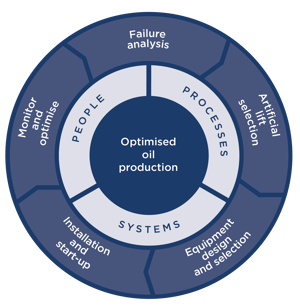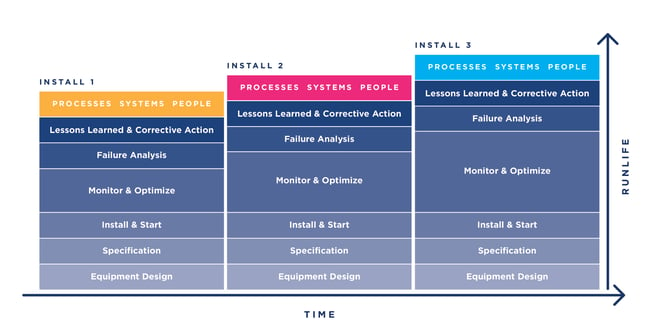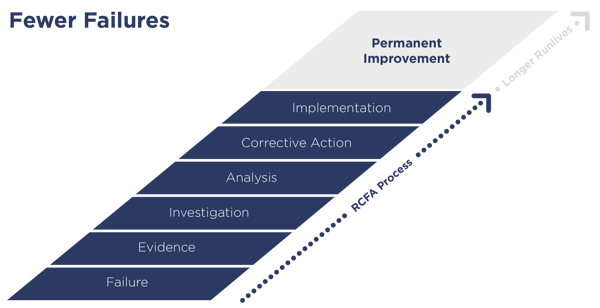Would you like to increase ESP runlife? I think the answer for most operators would be a resounding ‘yes’, especially in a low oil price environment.
The goal with ESPs (or, for that matter, any other artificial lift method) is runlife extension. Driving extended runlife significantly reduces artificial lift cost and Lease Operating Expense (LOE). This article will provide an overview of what we need to do differently to increase the runlife and reliability of ESPs.
On unconventional wells, it’s typical to see dismal runlife as shown in Figure 1. Would you be happy with this kind of runlife statistics – an average runlife of 142 days.
 Figure 1 - Dismal runlife
Figure 1 - Dismal runlife
As part of our consultancy work, we’ve used Figure 2 for years to represent the ESP lifecycle. The key is to implement the upper part of the lifecycle ‘failure analysis’ to improve equipment specification. I was teaching a course earlier this year for a client when it struck me like a bolt of lightning that this diagram is what we do, that is ‘so wrong’! This diagram represents doing the same thing over and over again – known as photocopy engineering. Albert Einstein called this the definition of stupidity: doing the same thing with the expectation of different results.

Figure 2 - ESP lifecycle
If we want to improve ESP runlife, what we really need to do is understand the cause of all failures and identify a corrective action to prevent the recurrence of the failure. This means evolving an ESP specification that is appropriate for the well operating conditions. I spent a little time thinking about how we could represent a process that more accurately reflects what we should be doing on our wells to drive improvement. We came up with Figure 3. This image represents learning from every failure, applying corrective actions and taking steps to improve, increasing our runlife on every subsequent installation.

Figure 3 - Progressive runlife improvement
Figure 4 represents what needs to happen for every failure to drive runlife improvement.

Figure 4 - Corrective actions drive runlife improvement
This doesn’t just apply to ESPs. I was consulting for a company in California in 2009, and they had a really good runlife on their rod pumps (2-3 years or more); however, they had a small population of wells that had repetitive short runlives. Short lives cost that company millions of dollars. Doing the same thing repeatedly was not working; the short runlives persisted.
The solution was to make sure that the person responsible for the replacement design did something different from the previous installation. Solutions were:
- having people attend pump teardowns and develop a corrective action;
- using VSDs to control the speed of the up and downstroke based on pump card;
- co-rod on wells with high deviation;
- improved materials for valves, plunger, and barrel.
Together, we were able to successfully extend runlife on these problem wells.
The recent Spears Q1 2020 Artificial Lift Report[1] stated that:
“US horizontal drilling – wells with extremely long laterals – encouraged the start-up of several ESP suppliers who specialized in renting inexpensive pumps.”
In my opinion, using inexpensive rented ESP systems on unconventional wells is madness! By default, these inexpensive systems are low specification or systems that have already been used and stressed in somebody else’s well.
Unconventional wells can be gassy, produce solids, may be hot, have changing flowrates with time, and are challenging. Think of unconventional wells as being the equivalent of going “off-roading”, you need a Ford F150, not a Fiesta!
In January of this year, I attended an SPE conference in Oman - ESP Journey to the Future, where I saw a presentation that showed that an ESP had achieved a runlife in excess of 10 years, in a steamflood, where temperatures were in excess of 425oF! For this operator, the specification they use in steamflood wells achieves better runlife, than they achieve on their lower temperature waterflood wells – proof that improved specification works. While 10 years might be overkill for an unconventional, 2 years would be a good target.
A 2 year runlife is perfectly achievable, our clients have wells that regularly get runlives greater than 2 years, with some wells in excess of 1000 days. Our software tracks these numbers, so we know the statistics. Assuming that it costs $200k per intervention and that current runlife is 6 months, extending runlife to 2 years could save $600k per well (double that number if you are getting 3 month runlives). And, if you think ‘no way’, then we can help you.
Figure 5 shows the improvement in ESP runlife for the same operator as Figure 1 – this improvement has been driven through the application of improved equipment specification.

Figure 5 - Operator from figure 1 with improved specification
Some solutions to your problems are:
|
Problem |
Solution(s) |
|
Declining flowrate |
|
|
Gas |
|
|
Solids production or frac sand flow back |
|
|
Tight casing |
|
We have implemented changes like these for several operators[2,3] who have achieved significant success with modest tweaks to their specifications. You don’t have to accept short runlives; there is a better way.
If you or your company would be interested in getting a better handle on your runlife and failure causes or being able to benchmark your (anonymized) ESP data against other operators in your basin, to drive down LOE/OPEX please do let us know.
References
- Q1 2020 Artificial Lift Report published by Spears & Associates.
- Improving ESP Application for Unconventional Wells in the Bakken by James Britvar (Oasis Petroleum LLC) and Sandy Williams (Artificial Lift Performance Ltd), SPE Gulf Coast Section Electric Submersible Pumps Symposium held in The Woodlands, Texas, USA, 2017
- Improving ESP Runlife in a New Field (Mississippi Lime); by Anville Francis, Jesse Allen (Chesapeake Corporation) Salvatore Grande (Magney Grande Distribution Inc) and Sandy Williams (Artificial Lift Performance Ltd) ), Society of Petroleum Engineers - Gulf Coast Section Electric Submersible Pump Workshop held in The Woodlands, Texas, 2015
.jpg?width=2097&height=770&name=ALP%20logo%20%26%20strapline%20-%20RGB%20(US%20version).jpg)


